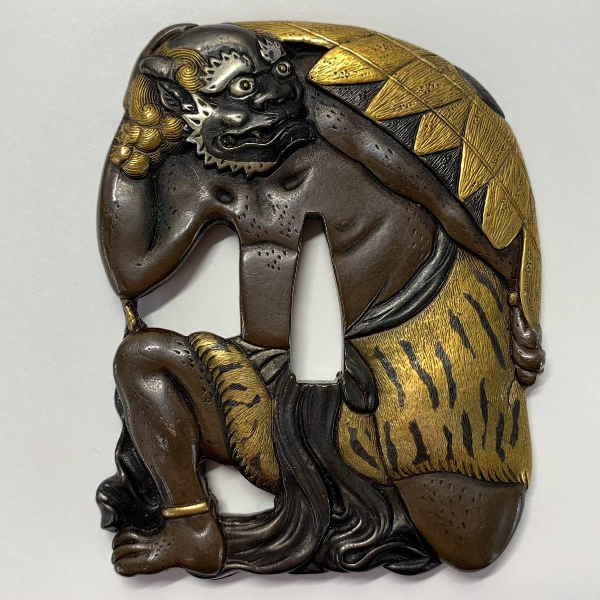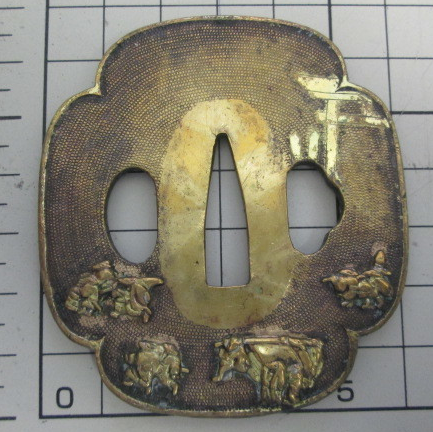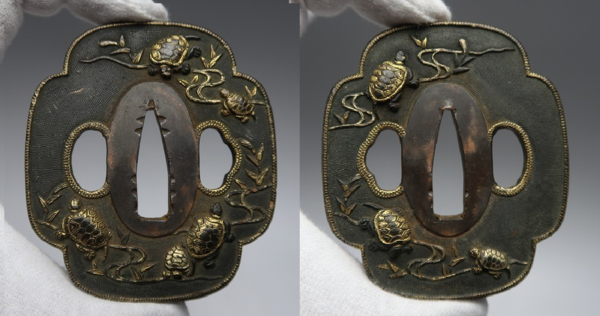-
Posts
3,703 -
Joined
-
Last visited
-
Days Won
100
Content Type
Profiles
Forums
Events
Store
Downloads
Gallery
Everything posted by Spartancrest
-
Yas one sold last night - https://www.jauce.com/auction/p817342531 not as nice, the window is empty. I have pictures of 18 utsushi [including the one you posted and this one] Samurai must have loved a good cup of tea! I know of two sets of daisho as well. The set here is described as Bushu also, but has no signature - so it may be a guess. We already have one Bulldog to pat - if she would get out of bed!
-
I like the Japanese idea of driving out evil spirits with sardines - but I think my idea will drive next doors cats away as well! I couldn't find any Holly so went for a garland of Japanese maple branches.
-

Koshirae on a Katana - Common to Have a Wak Tsuba?
Spartancrest replied to Infinite_Wisdumb's topic in Tosogu
If this is just Koshirae what is the tsuka stuck on? Unless there is a blade the tsuka has just been sat atop the tsuba - the wrong way around. Are there three mekugi-ana in the tsuka or is the top one a tear in the samegawa? The image is just not that clear but the lower mekugi-ana has no peg that I can see. -
Sorry but I keep finding new patterns - this one has a large butterfly motif- https://www.jauce.com/auction/u416256778 The quality of this one looks great.
-
Patrice, https://www.jauce.com/auction/p827924140 Peony and Shishi ? I like his slightly beaten up piece with the Oni and broken symbols - not so pretentious https://www.jauce.com/auction/w443259638
-

Interesting Odd Shape Tsuba for you collectors out there
Spartancrest replied to Infinite_Wisdumb's topic in Tosogu
Kobushi -gata [closed fist shape] one of the more common 'odd shaped' designs. The one you have pictured is a widely copied design, some are very recent cast fakes- I don't believe this one is fake, the workmanship looks good , I can't attest to the mei, but it could be genuine. The example from the Georg Oeder collection has the same mei. There is a poorer example in this thread - One of my big ugly kobushi brutes. -
The fukurin probably hides the construction method, not your usual Shingen that is for sure. Barry that Varshavsky one is a bit rough and ready - plenty of loose wires. He has another one that is dual personality but on the one face. We can't see the opposite side to see how it is constructed either. Is the double sided from your collection Peter?
-
I have been buying gear [mostly tsuba] for about seven years from Jauce. The packaging is so good you could literally drop it from a plane! The shipping at the moment is expensive DHL, was not so bad when EMS was open. The Jauce format is very different to eBay, you need to deposit your funds first before an auction, I find this an advantage as you can't spend what you don't have! They do drop in some strange fees though - deposit fee, banking fee, winning fee and you are charged the local postage cost getting to the Jauce warehouse [ even though I suspect the seller pays for that up front] I hope that doesn't put you off because the bargains you can get really out weigh the little fee nibbles. I have bought some items through auction for as low as 1 yen [with no other bidders] and a lot of identical material on eBay were four or five times the price - and you still pay shipping. The same items are often also listed on Yahoo Japan https://auctions.yahoo.co.jp/
-

who here buys from JAUCE
Spartancrest replied to lonely panet's topic in Auctions and Online Sales or Sellers
Hi Hamish I have been buying gear [mostly tsuba] for about seven years from Jauce. I agree with Ian the packaging is so good you could literally drop it from a plane! The shipping at the moment is expensive DHL, was not so bad when EMS was open. The Jauce format is very different to eBay, you need to deposit your funds first before an auction, I find this an advantage as you can't spend what you don't have! They do drop in some strange fees though - deposit fee, banking fee, winning fee and you are charged the local postage cost getting to the Jauce warehouse [ even though I suspect the seller pays for that up front] I hope that doesn't put you off because the bargains you can get really out weigh the little fee nibbles. I have bought some items through auction for as low as 1 yen [with no other bidders] and a lot of identical material on eBay were four or five times the price - and you still pay shipping. Have fun. -
-
Yas, Mushrooms is right!
-
Yas, is this one the same as the 'Wanted man' above? It is listed by a different seller? https://www.jauce.com/auction/b515768575 [https://www.jauce.com/auction/n488809158] has been cancelled? Or are we seeing more of these reproductions? The detailing is identical, but of course it would be if both are from the same factory?
-
Richard, It has the same features as the last one I posted with the leaves overlapping the rim - what do you think cast or utsushi? I am not a big fan of package deals they always contain some form of rubbish you don't want. [Not saying that guard is rubbish but you know what I mean]. Thanks for posting the image.
-
Do these ever end? https://www.jauce.com/auction/f488928175 https://www.jauce.com/auction/f487942011
-
It is a good thing Walt Disney didn't see those rabbits - or we would have had 'Usagi' the flying rabbit, Dumbo could never have competed. https://www.jauce.com/auction/533149538
-
Yet another pattern here - with matching fittings! https://www.jauce.com/auction/d480908604 It is a bit rough & ready.
-
For any Aussies Blurb have dropped their shipping rate for the Chosen-gafu book [matte] to $11.99. So a hardcover copy works out at AUD $46.05 and a soft cover AUD $34.05 that includes the shipping. I have no idea how long the shipping will stay at this price. Give me a pm if anyone is interested.
-
Sold for ¥ 101,000 High price for a modern replica! Yas- you can find this replica 'Wanted Man' - I don't think he is as good though! https://www.jauce.com/auction/n488809158
-

2020 wasn't all that bad... a recap of tsuba acquisitions
Spartancrest replied to Oshy's topic in Tosogu
Mauro there is another like yours here https://www.jauce.com/auction/d483683450 I don't know what you paid for yours, this one is not cheap. I am pretty sure this one is cast, not as good as yours. The rim is very plain -
-
Last Samurai , Avatar - all Dances with wolves rip offs. Kicking-Bird looked good in her wedding outfit you would have to agree? George, glad you didn't mention 'Wind in his trousers' a real stinker.
-
Robert there are about 810 or there about, unfortunately more than one third of the Museums collection are not available because of copyright - and those of course are some of the better examples. I would have had some thinner books if Bashford Dean had not been such a collector of what he hoped were Kaneie guards. He must have thought if you get enough you will get a good one eventually. No not bothered by any criticism I know the books are not perfect - I will take criticism more seriously from other authors though, they at least know how much work it takes. I am as guilty as anyone of picking works to pieces, that's very easy compared to doing the work. I have a critique by someone on the works of Helen C. Gunsaulus who wrote Japanese SWORD-MOUNTS IN THE COLLECTIONS OF FIELD MUSEUM. 1923 "Late in the seventies of last century [19th C] the Japanese sword became by official ban a virtual drug in the market of its native country and during the next two or three decades was exported wholesale to the West, together with huge quantities of the detachable metal mounts provided for the constructive strengthening and decoration of the blade itself and of its scabbard. These were bought up with avidity by a world eager for the art products of a hitherto almost unknown country, but it is safe to say that in the West (and even in Japan itself) serious research in the wide and difficult field of study afforded by the decorative furniture of the Japanese sword began only in the first decade of the present century. The appearance of the catalogues raisonnes of the Jacoby and Mosle collections, of Hara's annotated list of sword-furniture makers (the collector's Bible, to use a hackneyed phrase), and of the tentative excursions into the subject by Brinkley, de Tressan and a few others, was followed from 1911 onwards by a series of illuminating articles, the result of far-reaching research, enshrined in the Hawkshaw, Naunton, and “ Red Cross " catalogues and other works by the late H. L. Joly, through whose premature death in 1920 the world is still waiting for a comprehensive magnum opus that shall be the last word on the subject in hand. Miss Gunsaulus, who " has devoted more than two years to a thorough study of the entire subject," now valiantly steps into the breach with a handbook based on the collection given to Field Museum by her father, the late Dr. Frank W. Gunsaulus. In the preface Dr. Berthold Laufer confidently anticipates that " this volume, by its compact and critical presentation of the material at hand and the addition of novel information in respect to the metal craftsmen, will prove of interest and make an appeal to the students of Japan, as well as the ethnologists and folklorists in general.” And with this we may heartily and in general terms agree. But as one who has studied the subject for over fifteen years — and realizes how much there is yet to learn — the writer may perhaps be permitted to append a few criticisms in regard to details. In the first place, of the two-hundred-odd examples included in the plates, some one hundred and thirty, it is fairly obvious, are given on a much reduced scale — a serious fault, especially when combined with unequal photography, a tendency to bad lighting, and a somewhat woolly quality of printing. Next, it is clear that the author realizes the necessity, in such a work, of accuracy and uniformity in the spelling of foreign words and names, and has made a conscientious effort in that direction, an effort that has, alas ! to a very considerable extent, failed of fruition. For example, the important index of signatures, twenty pages long, contains some fifty mis-spellings, many of them elementary and obvious, but none the less annoying. Lack of space prevents more than a bare recital, in resume, of a string of inaccurate and misleading statements on pages 33-4 regarding constructive details of the sword. The absurdity of most of them will be patent to the tiro and they require but little comment ; (а) The tsuba (guard) is declared to be “ securely fastened ” to the tang of the blade by means of the fuchi (ferrule) ! (b) The two menuki are said to come ** immediately below " the kashira and to “ cover the mekugi (rivets)." (Notice the plural.) (c) Sometimes “ other menuki," it is stated, decorate the scabbard, and, if of some size, are called kanamono, in common with the metal ornaments of pouches. This term, literally " hardware " (sic), is accused of being misleading for objects of a purely artistic nature and quality. (Observe how the question is begged by the mistranslation.) (d) The habaki, says our author, fits into the tang-hole of the guard ! (e) The udenuki holes on guards are alluded to as if always found with the (purely conjectural) sword-knot. In short, it would seem as if Miss Gunsaulus has restricted her study entirely to detached mounts and to imperfectly understood written descriptions of the swords as fully fitted. Finally, on page 35 it is implied that " the alloy par excellence ” used in making sword-furniture is karakane (practically bronze), which in actual fact is very rarely found in extant specimens. To Mr. Koop's review I will add a note on Miss Gunsaulus's interpretation (p. 19) of the poem ; Honohono to Akashi no ura no Asa-giri ni Shima-gakure-yuku Fune wo shi zo omou. I am thinking of a boat That dimly, dimly In the morning mist Of the shore of Akashi Goes island-hid. Miss Gunsaulus says : ** B. Chamberlain and A. Waley have each interpreted the poem, translating the word shima-gakure ' island-hid.’ It is an old expression meaning ‘ things hidden in the distance of the sea,’ and not necessarily denoting any island.’’ This explanation is based on the Kokinshu Tokagami of Moto-ori (1730-1801) and is not accepted in most modern editions of the Kokinshu. Neither Moto-ori nor Miss Gunsaulus quote any other passage in which shima-gakure has this meaning. The difficulty is that there are no islands off the shore of Akashi. May not an earthquake have removed them ? A.D.W." A lot to read sorry, but what that all boils down to is - out of a whole book only five points were found to be wrong. Never seen any publications by the critics though. I am not having a shot just trying to show its not all that easy to organize a book, these days it is even harder if you are trying to get books out for as cheaply as possible - the middlemen make it very hard!
-
Ignacio - you have already got one order from Christian. You could become a trader overnight! Well if you do, keep me in mind for 110 !!!!!! Christian - 105, it is sure one of the best! Ignacio don't post the auction site - the prices will go up!
-
Hey I like the little turtles ! This is another to add to the list https://www.jauce.com/auction/d504988743
-
Hi Ignacio - you have stumbled on some pretty good examples - wish I had done that as a beginner! I personally like 110, I collect what attracts me, value and cost should not come into it unless you are a dealer. You could have the most expensive guard around and still hate the look of it. Go with your heart you will enjoy it more. You asked Curran what he would get and he gave a good answer. You could ask a hundred members what they like or would bid on and get a different answer each time. Welcome to NMB and have fun, it is a great hobby. As for prices on each that is very hard to judge, but there are no obvious duds in that group. [I would say it is getting to be good practice to show what you might bid on, here on NMB, if you are unsure, because there are many fakes that should be steered away from.]






















